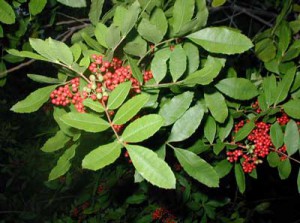
Is there a serious threat to Florida’s landscape living in your yard? Would you know a Brazilian peppertree, a carrotwood or a Cuban tree frog if you saw one? If not, read on.
Invasive species are defined as non-native or exotic organisms which cause environmental or economic harm, or negatively affect human health in an environment where they were not historically found. An invasive species can be a plant, animal, or other type of organism. Because invasive species’ natural predators and parasites usually are not present in the new environment, their populations can grow unchecked, causing major impacts.
Damage caused by invasive species can take different forms and in extreme cases can lead to the extinction of native species, harm the environment, destroy crops, or ruin recreational sites. Other impacts can include decreased land value and decreased tourism. Invasive weeds can produce skin irritation, trigger allergies and poison pets and livestock. They can clog waterways, kill native trees, and shade out crops, ornamentals and prized native flora. Invasive species are found in every imaginable habitat, including oceans, lakes, streams, wetlands, croplands, rangelands, natural areas, parks, forests, urban environments, yards and gardens (from National Invasive Species Awareness Week website).

Any introduced species may become a terrible problem over time. Brazilian peppertree, for example, was an ornamental plant sold in many nurseries in the 1960s. Today it is one of our worst invasives, causing extensive and costly damage to our environment.
Some of the most abundant, widespread, and harmful invasive species in Florida include citrus canker, citrus greening, Brazilian pepper, melaleuca, hydrilla, Chinese tallow tree, cane toad, Cogongrass, Japanese climbing fern, chinaberry and water hyacinth. Everyone knows about the Burmese pythons that have been spreading across the Everglades since 1996.
A few invasive species can have enormous economic and environmental impact. For example, the state spent more than $300 million to control citrus canker. Agricultural losses due to invasive plants, animals, and diseases, are estimated at $179 million annually in Florida.
You may even have some of these invasive plants or animals in your own yard. Lantana camara, Mexican petunia, sword fern, wedelia, camphor tree, asparagus fern, begonia, and calico vine are all invasive, yet many are still sold by nurseries. Most invasive species are introduced and spread by human activities. Ships, wood products, ornamental plants, and pet trade often carry uninvited and potential invasives into the U.S. It is our responsibility to know invasive species and not give them a home. For a list of invasive plants you can google the Florida Exotic Pest Plant Council, or visit www.fleppc.org. It will be an eye-opening experience.
We can help stop the spread of invasives by becoming aware of the problem, learning how to identify them, not inadvertently planting them and quickly removing them if they do show up. Better yet, if you stick with native plants you won’t have to worry about them becoming invasive. Also, always be sure to clean hiking boots, waders, boats and trailers, off-road vehicles and other gear to stop invasive species from hitching a ride to a new location. Never transport firewood, or release exotic animals or plants into the environment.
You can also help by sharing this information with your family, friends and neighbors. Volunteer to help remove invasives from natural areas, public lands or even your neighbors’ property (with permission). This might be an excellent project for Girl Scout or Boy Scout troops. Remember that each one of us can make a difference in our community and environment by knowing invasive species and acting properly to prevent their spread.
To learn more, visit http://www.nisaw.org/ or google National Invasive Species Awareness Week.
UF/IFAS Extension – An Equal Opportunity Institution.
References:
Center for Aquatic and Invasive Plants, University of Florida (http://plants.ifas.ufl.edu/)
Living Green Website, University of Florida (http://livinggreen.ifas.ufl.edu/landscaping/invasive_exotic_plants.html)
Florida Fish and Wildlife Commission (http://myfwc.com/)
 0
0
